Today's Pork Rib End with Tomato Basil Sauce features tender marinated pork, and a rich tomato-basil sauce, tossed with pasta. This recipe is perfect for hearty family dinners, and simple enough for weeknight meals. It's also a great way to use up any leftover meat, such as chops, sausages, or roasts.
Best of all, this recipe uses only basic ingredients, like fresh tomatoes, basil, and garlic. We're using a boneless pork rib end as the meat, but you're choice of pork or beef would work equally well, such as pork tenderloin, leftover beef roast, or even sliced sausages. In my opinion, this is a quintessential Sunday pasta dinner recipe, and one that I'm certain you'll love.
Now, without further delay, let's get to it.
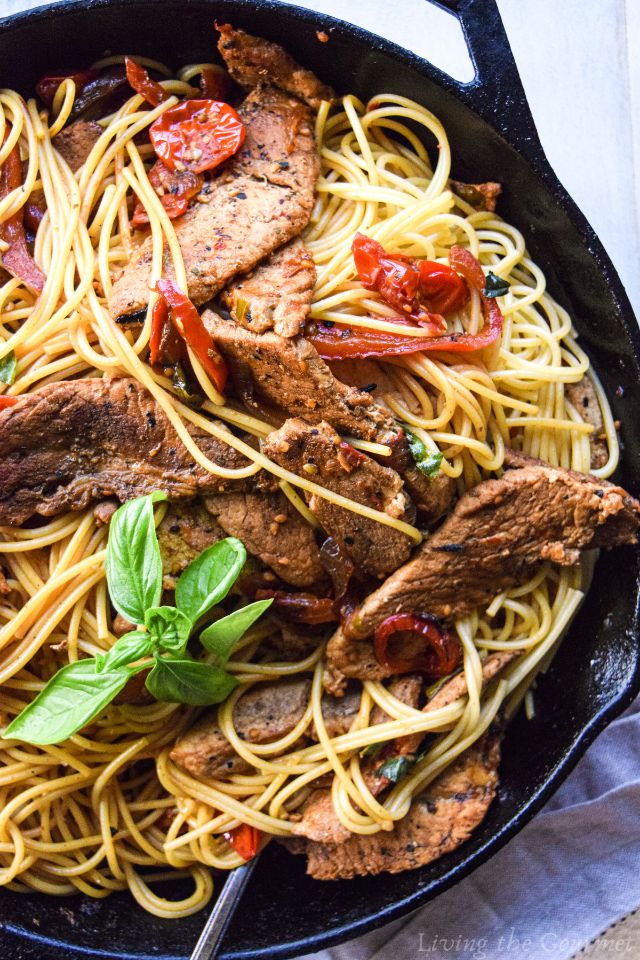
Recipe Overview - What to Expect
Taste and Texture
- Taste: We start the recipe by marinating the pork in olive oil, lemon juice, oregano, garlic powder, and red pepper. This should combine to create a bold Mediterranean flavor profile. We're combining the pork with a fresh marinara sauce made with onions, garlic, red bell peppers, grape tomatoes, and red pepper flakes.
- Texture: Cooked as directed, the pork should have a nice char, meaning slightly crisp, but juicy and tender on the inside. Meanwhile, we want to cook the pasta al dente so that we have a slightly firm noodle that won't become mushy when combined with the sauce (more on that below). Furthermore, we want the sauce to fully and evenly coat the pasta, so as to further enhance the overall mouthfeel of the dish. Tips below for cooking the perfect pasta every time.
Difficulty Level
- Moderate: This recipe is safely within the range of moderate difficulty. It includes slicing and marinating the pork, preparing the sauce, and cooking the pasta. However, if you follow the instructions below and take this recipe one step at a time, I promise you'll have a delicious pasta dish at the end.
Pairings
- Wine Pairing: The safe bet would be a Chianti. However, I could also envision pairing this dish with a light red such as a Pinot Noir, or a decent Pinot Grigio.
- Side Dishes: A simple green salad, roasted vegetables, crusty Italian bread, and a starter charcuterie platter would all work well to pair alongside today's pasta.
- Additional Toppings: A sprinkle of red pepper flakes, a drizzle of olive oil, or even a dollop of ricotta would all serve well. Just before serving, garnish with basil or parsley for added pop color.
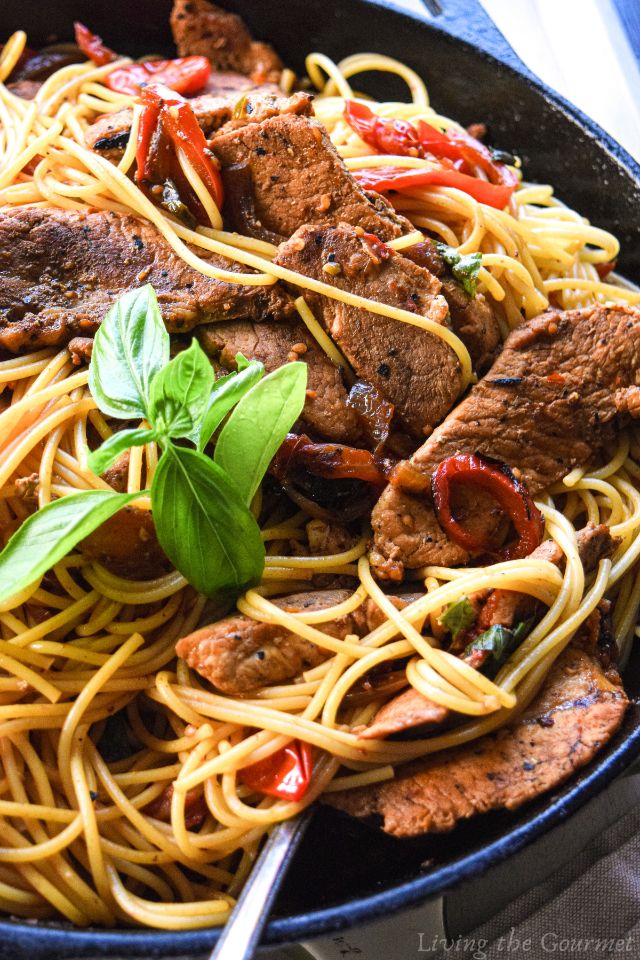
Ingredient Checklist - Everything You'll need
We're not using anything too fancy for this recipe, only basic ingredients readily available at your local supermarket. Here's the rundown on what you'll need:
For the Pork:
- 2½ lbs. Boneless pork rib end - sliced ¼ inch thickness
- Tip: Be sure to slice the pork thinly, as pictured, to ensure even cooking.
- Substitution: Yes, you can slice up boneless pork ribs, or pork tenderloin if preferred. Yes, beef also works with this recipe.
For the Marinade:
- 1 tsp. coarse black pepper
- Tip: As always, I do suggest freshly ground pepper for the best aromatics. Bonus points if using a mortar and pestle.
- 1 tsp. salt
- Note: Plain table salt is really all you need. Feel free to get fancy though.
- 1 tsp. sugar
- Note: To help balance out the acidity of the lemon juice.
- 1 tsp. garlic powder
- Substitution: Freshly minced garlic. I would suggest crushing and then chopping to garlic to ensure maximal release of its juices. Fresh garlic, however, will give a stronger garlic flavor to the pork.
- 1 tsp. dried oregano - crushed
- Tip: Be sure to thoroughly crush the oregano before adding it to the marinade. This helps both to release its oils and to ensure even distribution throughout the marinade.
- 1 tsp. red pepper flakes
- Substitution: Your preferred spicy chili flakes. Cayenne can also be used. Paprika can be used to give the marinade a smokier, though less spicy, flavor.
- 4 tbs. olive oil
- Tip: I really do suggest using a decent quality extra virgin olive oil for the recipe, as the oil will be seeping into the meat, flavoring it.
- 4 tbs. fresh lemon juice
- Tip: For brighter citrusy notes, use fresh lemon juice.
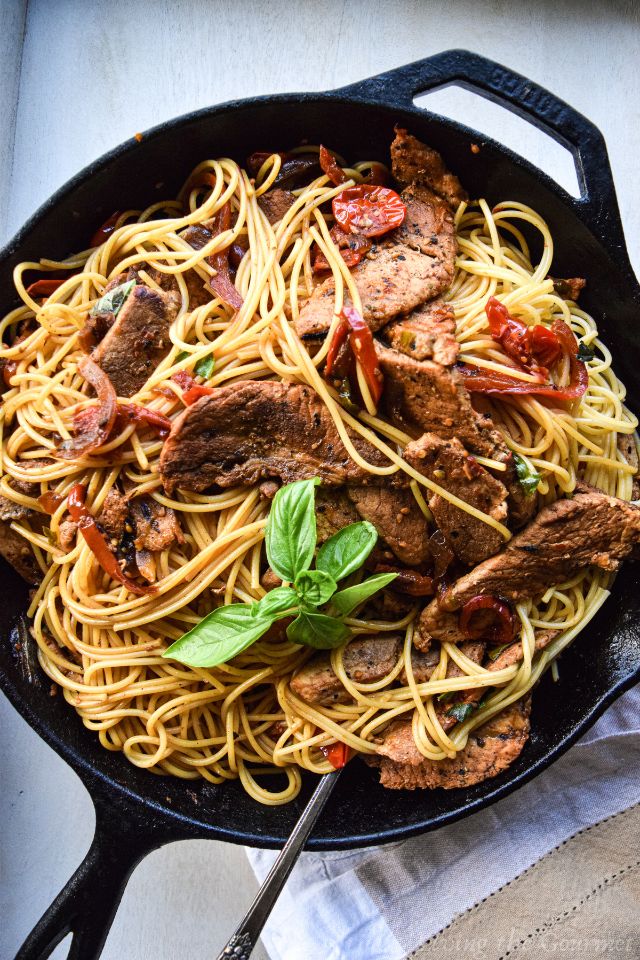
For the Sauce:
- 1 sweet onion - sliced
- Tip: I'm using regular sweet onions as a matter of preference.
- Substitution: Yellow onions, white onions, or even Vidalia can all be substituted if preferred.
- 4-5 garlic cloves - chopped
- Tip: Crush the garlic with the flat of your knife before chopping it to ensure maximal release of the juices.
- 1 red bell pepper - sliced thin
- Tip: Yes, any color bell pepper works.
- Substitution: Spicy peppers can be used instead if you're feeling adventurous.
- 1 pint of grape tomatoes
- Substitution: Any tomato will work in today's sauce. I'm using grape tomatoes purely because that's what I had on hand.
- Handful of fresh basil - plus more for garnish
- Note: Fresh basil adds a bright, anise-like flavor, and fresh aromatics.
- Substitution: Parsley or dried basil.
- ¼ cup of wine
- Tip: White wine, such as Sauvignon Blanc, works well. Don't use anything too fancy, cooking wine is really all you're looking for, or whatever you happen to have opened.
- 2 tbs. olive oil - plus more for drizzling
- Tip: Once again, a decent extra virgin olive oil works best.
- 1 tsp. salt
- Tip: Taste the sauce as it simmers, and then the amount of salt to suit your preference. Always taste as you go is a good rule to cook by, and one that I learned early on.
- 1 tsp. sugar
- Notes: Works to balance out the acidity of the tomatoes.
- 1 tsp. coarse ground black pepper
- Note: Here again, I do suggest freshly grinding the pepper.
- ½ tsp. red pepper flakes
- Tip: Adjust based on your spice preference. Yes, you can substitute with a pinch of cayenne.
- 1 tsp. dried oregano
- Tip: As above, crush the oregano before adding to the sauce.
For the Pasta:
- 1 lb. of your choice of pasta
- Tip: My go-to pasta would be spaghetti, penne, or linguine for this particular dish. But any pasta will do.
- Substitution: Yes, your gluten-free pasta of choice will work just fine.
- Fresh Parmesan cheese or Romano - for grating
- Tip: Freshly grated cheese simply has more flavor than its pre-grated counterparts, as pre-grating releases moisture, and as the moisture leaks from the cheese it loses flavor.
- Substitution: Any style of grating cheese will do, such as Pecorino Romano, Asiago, Romano, or parmesan.

Tips for Cooking Perfect Pasta
- Use a Large Pot:
- Tip: This should go without saying, but use a large, spacious pot that allows the pasta plenty of room to expand and for you to stir it. The noodles need enough room to move around in order to facilitate even cooking. Also, it's never fun when pasta boils over.
- Add Salt to the Water:
- Tip: Salt the water. Salt it 'a lot.' You want to basically be boiling your pasta in salt water. Seriously though, use about two tablespoons per four to six quarts of water.
- Bring Water to a Rolling Boil:
- Tip: Do not put the pasta in the water until the water has 'already' reached a brisk boil. The water needs to be bubbling vigorously before the pasta is added. This ensures even cooking and also helps to prevent the pasta from sticking together.
- Stir Occasionally:
- Tip: Every thirty to forty seconds, give the pasta a few stirs. This prevents clumping and prevents the pasta from sticking to the pot and burning.
- Check for Doneness Early:
- Tip: Start checking the pasta for doneness about 2 minutes before the package instructions suggest. Taste a piece to see if it's "al dente," meaning it's cooked but still has a firm bite.
- Reserve Pasta Water:
- Tip: I always suggest reserving a few ounces of the starchy pasta water. This water can be added to the sauce as needed to give it body - starch equals texture. Starch also helps the pasta and sauce adhere to one another. However, too much pasta water and you'll end up watering down the sauce. Only add as needed.
- Don't Rinse the Pasta:
- Tip: I don't know when, where, or why this became a thing, but it is absolutely not necessary. Rinsing pasta removes starch. Starch helps the sauce cling to the pasta. Sauce is what gives pasta taste, and helps give the sauce texture. As such, when you rinse pasta you are quite literally rinsing away flavor and texture. Don't do it.
- Toss with Sauce Immediately:
- Tip: Don't let your pasta sit after draining, as it will start to stick together and become stiff. Not good. Instead, immediately move the pasta into your sauce and toss it.
- Undercook for Baked Dishes:
- Tip: If you're using the pasta in a baked dish, cook it for 1-2 minutes less than "al dente." The pasta will continue to cook in the oven and absorb the sauce without becoming mushy.
- Use the Right Pasta Shape:
- Tip: Choose a pasta shape that complements your sauce. For example, long, thin noodles like spaghetti work well with light, oil-based sauces, while short, ridged shapes like penne or rigatoni hold up better with thicker, chunky sauces.

Pork Rib End with Tomato Basil Sauce
- Total Time: 40 minutes
- Yield: 4-6 1x
Ingredients
- 2 1/2 lbs. Boneless pork rib end, sliced 1/4 inch thickness
- 1 lb. of your choice of pasta
- Fresh Parmesan cheese or Romano, for grating
For the Marinade:
- 1 tsp. coarse black pepper
- 1 tsp. salt
- 1 tsp. sugar
- 1 tsp. garlic powder
- 1 tsp. dried oregano, crushed
- 1 tsp. red pepper flakes
- 4 tbs. olive oil
- 4 tbs. fresh lemon juice
For the Sauce:
- 1 sweet onion, sliced
- 4-5 garlic cloves, chopped
- 1 red bell pepper, sliced thin
- 1 pint of grape tomatoes
- Handful of fresh basil, plus more garnish
- 1/4 cup of wine
- 2 tbs. olive oil, plus more for drizzling
- 1 tsp. salt
- 1 tsp. sugar
- 1 tsp. coarse ground black pepper
- 1/2 tsp. red pepper flakes
- 1 tsp. dried oregano
Instructions
For the pork:
- Slice the pork to ¼-inch thickness and place in a large bowl.
- Combine the ingredients for the marinade and massage into the pork.
- Cover the bowl and refrigerate for at least one hour or up to overnight.
- Heat a large cast iron frying pan and add a few pieces of pork at a time.
- Allow the pork to slightly char on each side and cook through. The cooking time will depend on the thickness of the pork.
For the sauce:
- Heat a large cast iron frying pan.
- Add the sliced onion and red bell pepper. Allow the onion to slightly char.
- Add the tomatoes and garlic. Drizzle with the olive oil.
- Allow the tomatoes to soften and the garlic to become fragrant.
- When the tomatoes to soften, gently crush them.
- Add the wine, seasonings, and basil.
- Allow the sauce to simmer gently.
- Add the cooked pork to the sauce and cover loosely.
- Prepare the pasta as directed in well-salted water.
- Lift the pasta into the sauce.
- Add the extra basil and freshly grated cheese along with a drizzle of olive oil and serve.
- Prep Time: 15 minutes
- Cook Time: 25 minutes
And that's our Boneless Pork Rib End with Pasta. If you enjoyed today's post, or have any questions or suggestions, let us know in the comments below. We always love hearing from you.
Happy Cooking!
0
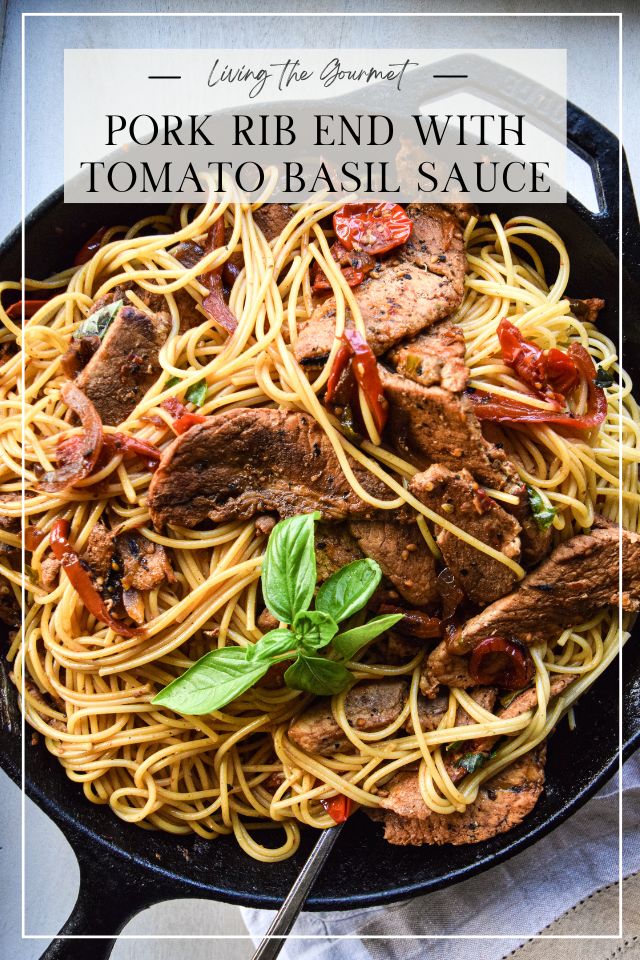
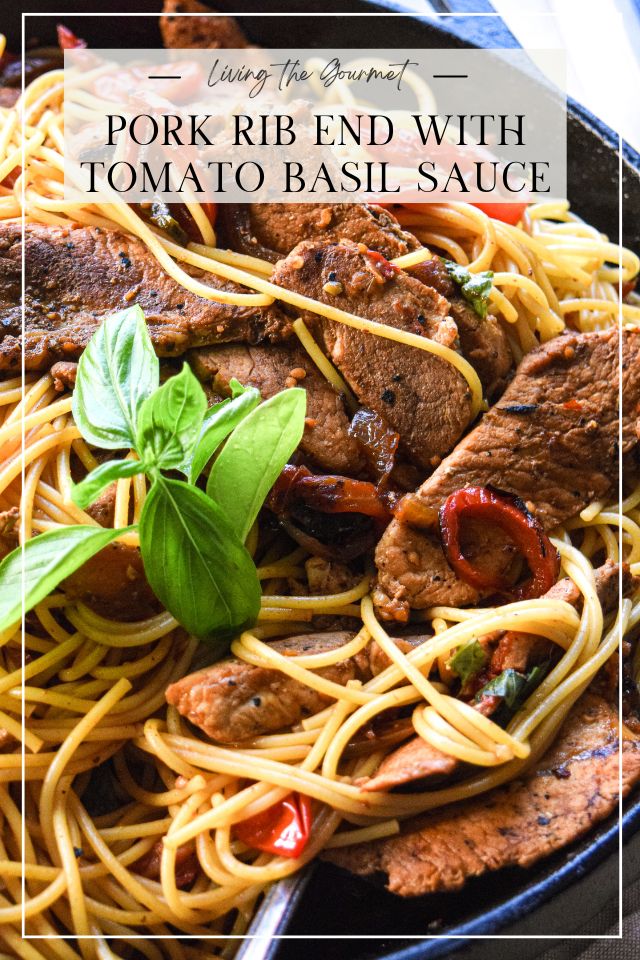
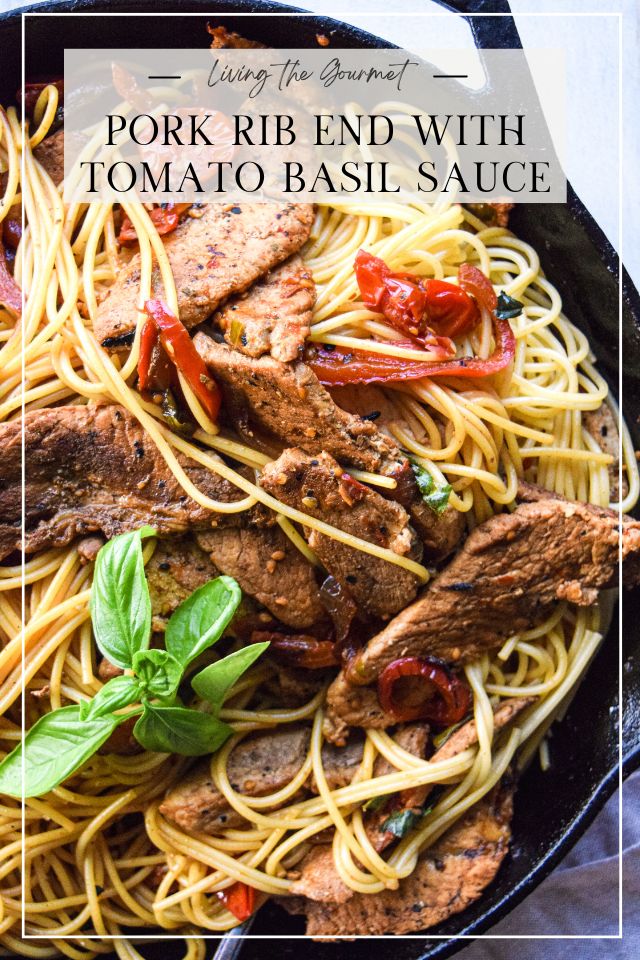

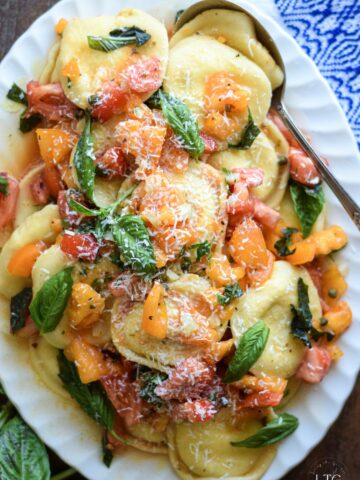
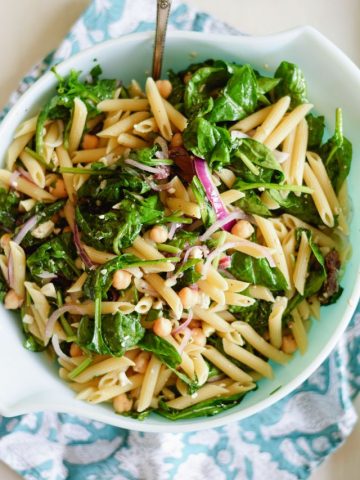
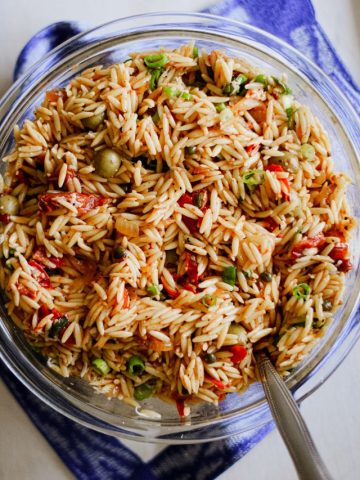
Leave a Comment